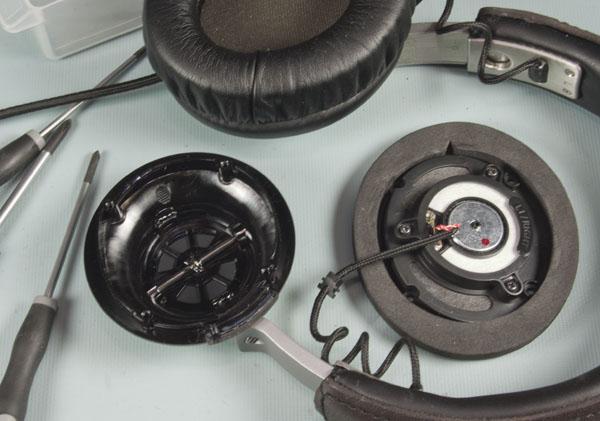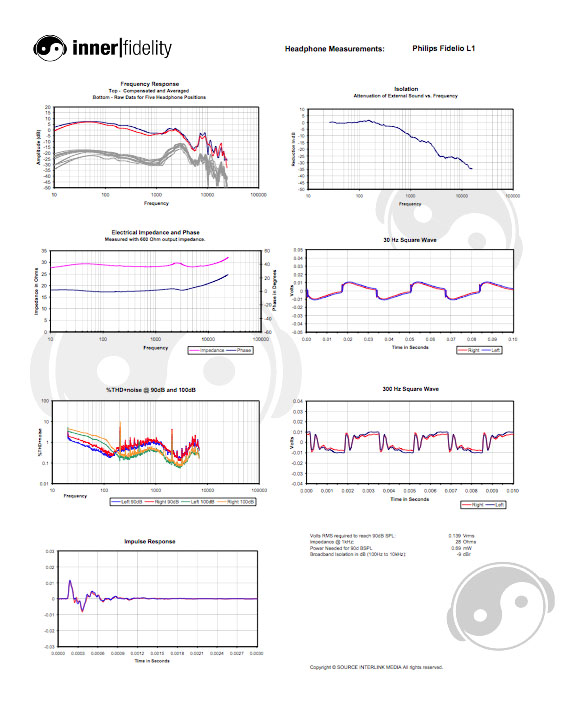| Columns Retired Columns & Blogs |
The Handsome Philips Fidelio L1 Page 2

Sound Quality
I'm not going to mince words here: these are not audiophile grade cans. They simply don't have the transparency and refinement of a truly great headphone. BUT! They deliver a very good mid-fi listening experience. The vast majority of headphones miss the boat by failing in some way or another. Not so with the Philips Fidelio L1, which perform well across the board. It's just not reference quality (not that any are at this price).
The L1 is a warm sounding can with substantial bass response, but the overall balance remains quite good. Bass is well extended, but mildly loose sounding; the bass accentuation may be a bit much for audiophiles, but will probably be very satisfactory for the general public. I've found that a well executed elevated bass response can be very satisfying for movie listening, and these cans have seen significant duty with Netflix on my iPad with a very enjoyable end result.
The bass transitions nicely into the mids, which are well balanced with a bit of accentuation in the upper-mid/low-treble region giving a solid sense of presence to vocals. The treble is just about right in level, but lacks refinement. Cymbals are slightly papery sounding and lack air, but the treble remains well proportioned and ready to deliver without becoming aggressive.
I find the imaging with these cans about average for a headphone at this price. While the angled drivers may help the L1 in terms of imaging, I think the slightly unnatural treble may hurt. The dynamic punch of the L1 is quite good; the big bass and a snappy upper-midrange go a long way towards delivering solid impact.
I continue to be surprised with the sense of overall balance to these cans. So often warm and/or bass heavy cans will sound muffled, not so with the L1. While I can nit pick my way through their response and find fault, when I simply relax and listen the L1 always seems to deliver a solid sonic experience. I'm really not sure how Philips managed this little trick, but they did.
Click on graphs image to download .pdf for closer inspection.
Raw frequency response measurements of the L1 show some broad changes in level with movement, possibly as a result of the angled driver. Compensated frequency response clearly shows a general warm tilt with a broad bass hump centered at about 60Hz, which falls of very little below evidencing good bass extension. From 100Hz to 1kHz response is nicely free of artifact.
The moderate bump between 1kHz and 3kHz is likely responsible for the vocal presence heard in listening. I usually like to see a headphone that is flat to between 1kHz and 2kHz, with a downward trend to about 6kHz which will prevent them from sounding hard. If these headphones were flat to 1kHz and had this bump I'd be worried about it being a hard sounding, but in the case of the L1 I think the elevated bass tends to mediate the effects of the 1-3kHz bump. It may be that this wide presence peak is helpful counterbalancing the accentuated bass and gives these headphones the sense of balance I observed. The peak at 8-10kHz is very common, and lower than most in this case; the treble level above 10kHz is about exactly where I'd like to see it.
I find it very interesting that this particular mix of warm tilt through the mids; presence peak; and well controlled response above 8kHz delivers the nicely balanced presentation heard. The Spider Realvoice (measurements here), which was designed to favor vocals, has a similar shape, though the highs roll off to a greater extent.
30Hz square wave response shows a typical shape for a warm, punchy headphone with fairly tight bass response, but the THD+noise plots show some loss of control below 200Hz with the 100dB line crossing over the 90dB line indicating some power handling troubles in the lows, which may indicate the mild looseness heard in listening.
300Hz square wave response shows the leading edge not overshooting the wave top, which indicates headphones that are gentle on the ears, but the large rebound downward immediately after the leading edge and subsequent rise to the wave top may be indicative of the papery treble and only average imaging heard.
Impulse response plot shows a fairly quick peak followed by some significant ring, which does damp rather quickly and is fairly noise free. Lack of noise may be due to the aluminum cups, and is similar to the response of the Sennheiser Amperior in that way.
The isolation plot shows a headphone with modest abilities to rid outside noise. Broadband isolation of -9dB is fairly good for a semi-open headphone, and betters the Denon D5000's meager -6dB figure. These cans will work well in moderate ambient noise level environs.
The impedance plot is fairly free of small bumps and wiggles that often occur with driver resonances. This indicates to me a good deal of care was exercised with the design of these cans. Fairly flat 28 Ohm impedance means these cans will sound good from most portable sources, but the fairly high 139mVrms needed to drive them to 90dB SPL means they're not going to be very loud. I did double check this number and got a marginally lower reading; when playing the L1 on an iPhone and Galaxy Nexus I had no problem reaching solid listening levels, however.
Summary
 I've got a whole lot of headphones around the house, but I find myself gravitating to the Philips Fidelio L1 more often than any other. Sure, I've got better sounding cans, but none are as versatile, attractive, and comfortable. I love snatching them up for long calls to my daughter in NY--who speaks far too fast for me to understand without a good sounding headset. I relish my time with the L1 watching movies where the warm sound puts "oomph" into my film experience, and they stay on my head nicely as I roll in and out of bed. Simply put, the Philips Fidelio L1 is an absolutely terrific general purpose headphone. They're making it to my "Wall of Fame" as a great gentleman's headphone, perfect for duties around the home and office.
I've got a whole lot of headphones around the house, but I find myself gravitating to the Philips Fidelio L1 more often than any other. Sure, I've got better sounding cans, but none are as versatile, attractive, and comfortable. I love snatching them up for long calls to my daughter in NY--who speaks far too fast for me to understand without a good sounding headset. I relish my time with the L1 watching movies where the warm sound puts "oomph" into my film experience, and they stay on my head nicely as I roll in and out of bed. Simply put, the Philips Fidelio L1 is an absolutely terrific general purpose headphone. They're making it to my "Wall of Fame" as a great gentleman's headphone, perfect for duties around the home and office.
The other great gentleman's headphone is the B&W P5 at the same price, which has a similar sound signature; is more compact; but is not quite as secure and comfortable on the head. For better sound at this price/type, check out the Denon AH-D2000 and AKG K550, but these cans won't be as versatile as the Philips L1.
Resources
Head-Fi threads here, here, and here.
Philips Fidelio L1 product page.
- Log in or register to post comments





































